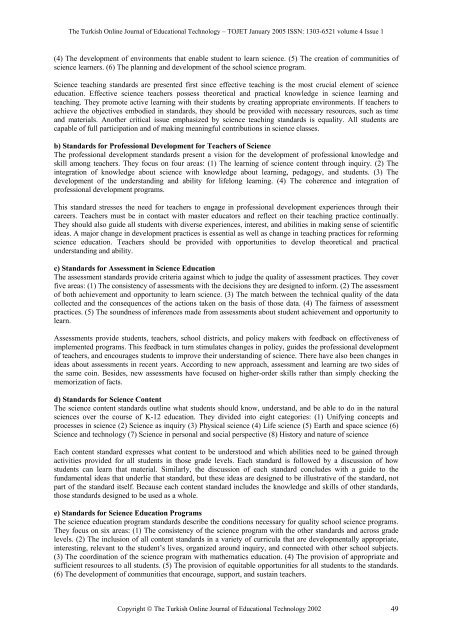Age - TOJET the Turkish online journal of educational technology
Age - TOJET the Turkish online journal of educational technology
Age - TOJET the Turkish online journal of educational technology
Create successful ePaper yourself
Turn your PDF publications into a flip-book with our unique Google optimized e-Paper software.
The <strong>Turkish</strong> Online Journal <strong>of</strong> Educational Technology – <strong>TOJET</strong> January 2005 ISSN: 1303-6521 volume 4 Issue 1<br />
(4) The development <strong>of</strong> environments that enable student to learn science. (5) The creation <strong>of</strong> communities <strong>of</strong><br />
science learners. (6) The planning and development <strong>of</strong> <strong>the</strong> school science program.<br />
Science teaching standards are presented first since effective teaching is <strong>the</strong> most crucial element <strong>of</strong> science<br />
education. Effective science teachers possess <strong>the</strong>oretical and practical knowledge in science learning and<br />
teaching. They promote active learning with <strong>the</strong>ir students by creating appropriate environments. If teachers to<br />
achieve <strong>the</strong> objectives embodied in standards, <strong>the</strong>y should be provided with necessary resources, such as time<br />
and materials. Ano<strong>the</strong>r critical issue emphasized by science teaching standards is equality. All students are<br />
capable <strong>of</strong> full participation and <strong>of</strong> making meaningful contributions in science classes.<br />
b) Standards for Pr<strong>of</strong>essional Development for Teachers <strong>of</strong> Science<br />
The pr<strong>of</strong>essional development standards present a vision for <strong>the</strong> development <strong>of</strong> pr<strong>of</strong>essional knowledge and<br />
skill among teachers. They focus on four areas: (1) The learning <strong>of</strong> science content through inquiry. (2) The<br />
integration <strong>of</strong> knowledge about science with knowledge about learning, pedagogy, and students. (3) The<br />
development <strong>of</strong> <strong>the</strong> understanding and ability for lifelong learning. (4) The coherence and integration <strong>of</strong><br />
pr<strong>of</strong>essional development programs.<br />
This standard stresses <strong>the</strong> need for teachers to engage in pr<strong>of</strong>essional development experiences through <strong>the</strong>ir<br />
careers. Teachers must be in contact with master educators and reflect on <strong>the</strong>ir teaching practice continually.<br />
They should also guide all students with diverse experiences, interest, and abilities in making sense <strong>of</strong> scientific<br />
ideas. A major change in development practices is essential as well as change in teaching practices for reforming<br />
science education. Teachers should be provided with opportunities to develop <strong>the</strong>oretical and practical<br />
understanding and ability.<br />
c) Standards for Assessment in Science Education<br />
The assessment standards provide criteria against which to judge <strong>the</strong> quality <strong>of</strong> assessment practices. They cover<br />
five areas: (1) The consistency <strong>of</strong> assessments with <strong>the</strong> decisions <strong>the</strong>y are designed to inform. (2) The assessment<br />
<strong>of</strong> both achievement and opportunity to learn science. (3) The match between <strong>the</strong> technical quality <strong>of</strong> <strong>the</strong> data<br />
collected and <strong>the</strong> consequences <strong>of</strong> <strong>the</strong> actions taken on <strong>the</strong> basis <strong>of</strong> those data. (4) The fairness <strong>of</strong> assessment<br />
practices. (5) The soundness <strong>of</strong> inferences made from assessments about student achievement and opportunity to<br />
learn.<br />
Assessments provide students, teachers, school districts, and policy makers with feedback on effectiveness <strong>of</strong><br />
implemented programs. This feedback in turn stimulates changes in policy, guides <strong>the</strong> pr<strong>of</strong>essional development<br />
<strong>of</strong> teachers, and encourages students to improve <strong>the</strong>ir understanding <strong>of</strong> science. There have also been changes in<br />
ideas about assessments in recent years. According to new approach, assessment and learning are two sides <strong>of</strong><br />
<strong>the</strong> same coin. Besides, new assessments have focused on higher-order skills ra<strong>the</strong>r than simply checking <strong>the</strong><br />
memorization <strong>of</strong> facts.<br />
d) Standards for Science Content<br />
The science content standards outline what students should know, understand, and be able to do in <strong>the</strong> natural<br />
sciences over <strong>the</strong> course <strong>of</strong> K-12 education. They divided into eight categories: (1) Unifying concepts and<br />
processes in science (2) Science as inquiry (3) Physical science (4) Life science (5) Earth and space science (6)<br />
Science and <strong>technology</strong> (7) Science in personal and social perspective (8) History and nature <strong>of</strong> science<br />
Each content standard expresses what content to be understood and which abilities need to be gained through<br />
activities provided for all students in those grade levels. Each standard is followed by a discussion <strong>of</strong> how<br />
students can learn that material. Similarly, <strong>the</strong> discussion <strong>of</strong> each standard concludes with a guide to <strong>the</strong><br />
fundamental ideas that underlie that standard, but <strong>the</strong>se ideas are designed to be illustrative <strong>of</strong> <strong>the</strong> standard, not<br />
part <strong>of</strong> <strong>the</strong> standard itself. Because each content standard includes <strong>the</strong> knowledge and skills <strong>of</strong> o<strong>the</strong>r standards,<br />
those standards designed to be used as a whole.<br />
e) Standards for Science Education Programs<br />
The science education program standards describe <strong>the</strong> conditions necessary for quality school science programs.<br />
They focus on six areas: (1) The consistency <strong>of</strong> <strong>the</strong> science program with <strong>the</strong> o<strong>the</strong>r standards and across grade<br />
levels. (2) The inclusion <strong>of</strong> all content standards in a variety <strong>of</strong> curricula that are developmentally appropriate,<br />
interesting, relevant to <strong>the</strong> student’s lives, organized around inquiry, and connected with o<strong>the</strong>r school subjects.<br />
(3) The coordination <strong>of</strong> <strong>the</strong> science program with ma<strong>the</strong>matics education. (4) The provision <strong>of</strong> appropriate and<br />
sufficient resources to all students. (5) The provision <strong>of</strong> equitable opportunities for all students to <strong>the</strong> standards.<br />
(6) The development <strong>of</strong> communities that encourage, support, and sustain teachers.<br />
Copyright © The <strong>Turkish</strong> Online Journal <strong>of</strong> Educational Technology 2002 49
















